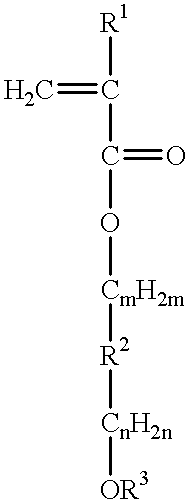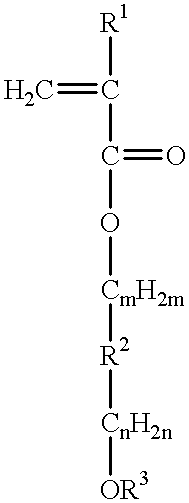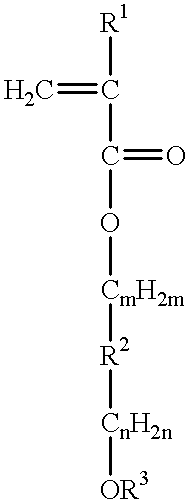Chemically amplified resist large in transparency and sensitivity to exposure light less than 248 nanometer wavelength and process of forming mask
a technology of amplified resist and lithography, which is applied in the direction of photosensitive materials, instruments, photomechanical equipment, etc., can solve the problems of reducing the production cost of ultra large-scale integration, reducing the cost of laser source gas, and prior art photo-sensitive synthetic resin compound is hardly available for lithography
- Summary
- Abstract
- Description
- Claims
- Application Information
AI Technical Summary
Benefits of technology
Problems solved by technology
Method used
Image
Examples
eighth example
Carboxynorbornylmethacrylate was synthesized as follows. ##STR27##
Bicyclo [2.2.1] hepto-5-ene-2-carboxylic acid tert-butylester of 50 grams and methacrylic acid of 133 grams are mixed with concentrated sulphuric acid of 1.35 grams and water of 2 grams in a 200 milli-litter three-port flask, and the reaction was continued at 60 degrees to 70 degrees in centigrade for five hours. The resultant material remained cooled, and the residual methacylic acid was distillated in vacuum. The residual material was separated and refined by using a silica gel column, and we obtained the objective compound of 2 grams.
Elemental Analysis Report (percent by weight)
C: 65.7 (65.60); H: 9.7 (9.44).
The value in parentheses was calculated value of C.sub.17 H.sub.24 O.sub.4 (the molecular weight of which was 256.3412).
IR (cm.sup.-1): 2400-3600 (.upsilon..sub.OH), 2960-2880 (.upsilon..sub.CH), 1704 (.upsilon..sub.C=0), 1628 (.upsilon..sub.C=C), 1168 (.upsilon..sub.C-0).
.sup.1 H-NMR (CDCl.sub.3, Internal Refe...
ninth example
Carboxytricyclodecanedimethanolmonomethacylate was synthesized as follows. ##STR28##
A 500 milli-litter four-port flask with a thermometer was assembled with a drying tube of calcium chloride and a constant-pressure dropping funnel. Tricyclo [5.2.1.0.sup.2,6 ] decane-4,8-dimethanol, which is assigned product number B4,590-9 manufactured by Aldrich Chemical Company, inc. in the U.S.A., of 50 grams equivalent to 0.25 mole and dry pyridine of 25.76 grams equivalent to 0.25 mole are mixed with dry tetrahydrofuran of 300 in the flask. The solution was agitated, and was cooled in iced water. Methacryloyl chloride, which was manufactured by Tokyo Kasei Corporation, of 26.53 grams equivalent to 0.25 mole was dissolved in dry tetrahydrofuran of 100 milli-litter, and the solution was dropped from the dropping funnel into the flask during strong agitation with a teflon bar.
After the dropping, the resultant material was agitated and cooled in iced water for an hour, and the reaction was continue...
tenth example
Carboxytetracyclodecenmethacrylate was synthesized as follows. ##STR29##
8-tertial-buthytoxycarboniltetracyclo [4.4.0.1.sup.2,5.1.sup.7,10 ]-3-dodecene of 10 grams was mixed with dry THF of 25 milli-litter in a 200 milli-litter four-port flask, and the resultant material was cooled to 0 degree in centigrade. The ambience was replaced with argon, and THF solution of 1M boran-THF complex was dropped into the flask by 20 milli-litter. The solution was agitated at 0 degrees in centigrade for an hour and at room temperature for an hour. The resultant material was cooled to 0 degree in centigrade, and water was dropped by 3 milli-litter. Moreover, 3M water solution of NaOH and 30% solution of H.sub.2 O.sub.2 were dropped by 6.6 milli-litter and 4.3 milli-litter, respectively at 20 degrees or less. The solution was agitated at room temperature for 1.5 hours, and water was saturated with NaCl. The resultant material was diluted with ether of 100 milli-litter. The ether layer was washed in sa...
PUM
| Property | Measurement | Unit |
|---|---|---|
| Fraction | aaaaa | aaaaa |
| Fraction | aaaaa | aaaaa |
| Percent by mass | aaaaa | aaaaa |
Abstract
Description
Claims
Application Information
 Login to View More
Login to View More - R&D
- Intellectual Property
- Life Sciences
- Materials
- Tech Scout
- Unparalleled Data Quality
- Higher Quality Content
- 60% Fewer Hallucinations
Browse by: Latest US Patents, China's latest patents, Technical Efficacy Thesaurus, Application Domain, Technology Topic, Popular Technical Reports.
© 2025 PatSnap. All rights reserved.Legal|Privacy policy|Modern Slavery Act Transparency Statement|Sitemap|About US| Contact US: help@patsnap.com



